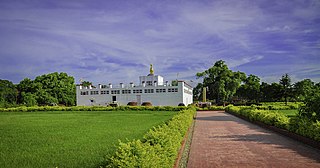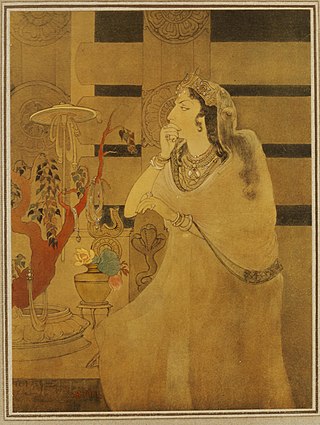Related Research Articles

Ashoka, popularly known as Ashoka the Great, was the third Mauryan Emperor of Magadha in the Indian subcontinent during c. 268 to 232 BCE. His empire covered the largest part of the Indian subcontinent, stretching from present-day Afghanistan in the west to present-day Bangladesh in the east, with its capital at Pataliputra. A patron of Buddhism, he is credited with playing an important role in the spread of Buddhism across ancient Asia.
A queen consort is the wife of a reigning king, and usually shares her spouse's social rank and status. She holds the feminine equivalent of the king's monarchical titles and may be crowned and anointed, but historically she does not formally share the king's political and military powers, unless on occasion acting as regent.

Lumbinī is a Buddhist pilgrimage site in the Rupandehi District of Lumbini Province in Nepal. It is the place where, according to Buddhist tradition, queen Maya gave birth to Siddhartha Gautama at around 566 BCE. Gautama, who, according to Buddhist tradition, achieved Enlightenment some time around 528 BCE, became Shakyamuni Buddha and founded Buddhism. Lumbini is one of many magnets for pilgrimage that spring up in places pivotal to the life of the Buddha.

The Bodhi Tree, also called the Mahabodhi Tree, Bo Tree, is a large sacred fig tree located in Bodh Gaya, Bihar, India. Siddhartha Gautama, the spiritual teacher who became known as the Buddha, is said to have attained enlightenment or buddhahood circa 500 BCE under this tree. In religious iconography, the Bodhi Tree is recognizable by its heart-shaped leaves, which are usually prominently displayed.

Bindusara was the second Mauryan emperor of Magadha in Ancient India. The ancient Greco-Roman writers called him Amitrochates, a name likely derived from his Sanskrit title Amitraghāta.

Mahāvaṃsa is the meticulously kept historical chronicle of Sri Lanka until the period of Mahasena of Anuradhapura. It was written in the style of an epic poem written in the Pali language. It relates the history of Sri Lanka from its legendary beginnings up to the reign of Mahasena of Anuradhapura covering the period between the arrival of Prince Vijaya from India in 543 BCE to his reign and later updated by different writers. It was first composed by a Buddhist monk at the Mahavihara temple in Anuradhapura in the 5th or 6th century CE.

Mahinda was an Indian Buddhist monk depicted in Buddhist sources as bringing Buddhism to Sri Lanka. He was the first-born son and Prince of the third Mauryan Emperor Ashoka The Great from his first wife and Empress Devi and the elder brother of Princess Sanghamitra.

Saṅghamittā was an Indian Buddhist nun and believed to be the eldest daughter of Emperor Ashoka and his first wife and Empress, Devi. Together with her brother Mahinda, she entered an order of Buddhist monks. The two siblings later went to Sri Lanka to spread the teachings of Buddha at the request of King Devanampiya Tissa who was a contemporary of Ashoka. Ashoka was initially reluctant to send his daughter on an overseas mission. However, because of the insistence of Sangamitra herself, he finally agreed. She was sent to Sri Lanka together with several other nuns to start the nun-lineage of Bhikkhunis at the request of King Tissa to ordain queen Anulā and other women of Tissa's court at Anuradhapura who desired to be ordained as nuns after Mahindra converted them to Buddhism.

Jaya Sri Maha Bodhi is a historical sacred bo tree in the Mahamewuna Garden in historical city of Anuradhapura, Sri Lanka. This is believed to be a tree grown from a cutting of the southern branch from the historical sacred bo tree, Sri Maha Bodhi, which was destroyed during the time of Emperor Ashoka the Great, at Buddha Gaya in India, under which Siddhartha Gautama (Buddha) attained Enlightenment. The Buddhist nun Sangamitta Maha Theri, a daughter of Indian Emperor Ashoka, in 236 BC, brought the tree cutting to Sri Lanka during the reign of Sinhalese King Devanampiya Tissa.[1] At more than 2,300 years old, it is the oldest living human-planted tree in the world with a known planting date. The Mahavamsa, or the great chronicle of the Sinhalese, provides an elaborate account of the establishment of the Jaya Siri Maha Bodhi on the Island and the subsequent development of the site as a major Buddhist pilgrimage site.

Kaurvaki was the "Second Queen Consort" of the third Mauryan emperor, Ashoka. She was Ashoka's fourth wife and 2nd chief empress consort. She was the mother of Ashoka's fourth son, Prince Tivala.
Kunala was the Crown Prince and second son of 3rd Mauryan Emperor Ashoka and Empress Padmavati and the presumptive heir to Ashoka, thus the heir to the Mauryan Empire which once ruled almost all of the Indian subcontinent. After the departure of Mahendra, Ashoka's eldest son, he was supposed to be the heir to the empire, but was blinded by his step-mother, Tishyaraksha, at a young age in jealousy. While he was not able to take the throne, his son, Samprati, became his heir.

Tissa, later Devanampiya Tissa, meaning, was one of the earliest kings of Sri Lanka based at the ancient capital of Anuradhapura. According to the traditional chronology, he ruled from 307 BC to 267 BC, but the modified chronology adopted by modern scholars such as Wilhelm Geiger assigns his reign to 247 BC to 207 BC. His reign was notable for the arrival of Buddhism in Sri Lanka under the aegis of the Mauryan Emperor Ashoka the Great. The primary source for his reign is the Mahavamsa, which in turn is based on the more ancient Dipavamsa.

The Dīpavaṃsa is the oldest historical record of Sri Lanka. The chronicle is believed to be compiled from Atthakatha and other sources around the 3rd to 4th century CE. Together with the Mahāvaṃsa, it is the source of many accounts of the ancient history of Sri Lanka and India. Its importance resides not only as a source of history and legend but also as an important early work in Buddhist and Pali literature.

Tishyaraksha or Tissarakkhā was the fifth and last wife of the third Mauryan emperor, Ashoka. According to the Ashokavadana, she was responsible for blinding Ashoka's son and heir presumptive Kunala. She was very jealous of the attention paid by Ashoka to the Bodhi-tree, and caused it to be killed by means of poisonous thorns.

The Anuradhapura period was a period in the history of Sri Lanka of the Anuradhapura Kingdom from 377 BCE to 1017 CE. The period begins when Pandukabhaya, King of Upatissa Nuwara moved the administration to Anuradhapura, becoming the kingdom's first monarch. Anuradhapura is heralded as an ancient cosmopolitan citadel with diverse populations.
Maharani Devi was, according to the Sri Lankan chronicles, the first wife and one of the Empress of the third Mauryan Emperor Ashoka The Great. She was also the mother of Ashoka's first two children—his son, Mahendra, and daughter, Sanghamitra—both of whom played important roles in the spread of Buddhism to other countries. She is also remembered for the Sanchi Stupa.

Maya Devi Temple is an ancient Buddhist temple situated at the UNESCO World Heritage Site of Lumbini, Nepal. It is the main temple at Lumbini, a site traditionally considered the birthplace of Gautama Buddha. The temple stands adjacent to a sacred pool and a sacred garden. The archaeological remains at the site were previously dated to the third-century BCE brick buildings constructed by Ashoka. A sixth-century BCE timber shrine was discovered in 2013.
The information about Mother of Ashoka The Great, the 3rd Mauryan emperor of ancient India, varies between different sources. Ashoka's own inscriptions and the main texts that provide information about his life do not name his mother. The Asokavadanamala names her Subhadrangi, while Vamsatthapakasini calls her Dharma. Different texts variously describe her as a Brahmin or a Kshatriya.

The Vajrasana, or Enlightenment Throne of the Buddha, is an ancient stone slab located under the Bodhi tree, directly beside the Mahabodhi Temple at Bodh Gaya. The slab is thought to have been placed at Bodhgayā by Emperor Ashoka The Great of the Maurya Empire between 250-233 BCE, at the spot where the Buddha meditated.

The Minor Pillar Edicts of Indian Emperor Ashoka refer to 4 separate minor Edicts of Ashoka inscribed on columns(Pillars of Ashoka) at 5 locations which are among the earliest dated inscriptions of any Indian monarch. A full English translation of the Edicts was published by Romila Thapar.
References
- 1 2 Barua, Beni Madhab; Topa, Ishwar Nath (1968). Asoka and his inscriptions. Vol. 1. New Age Publishers. p. 53.
- 1 2 3 4 5 Gupta, Subhadra Sen (8 September 2009). Ashoka: The Great and Compassionate King. Penguin Books. ISBN 978-81-8475-807-8 . Retrieved 25 September 2020.
- 1 2 3 4 The Maha Bodhi: Volume 104. University of Michigan. 1996. pp. 25–26.
- 1 2 3 Holt, John Clifford; Kinnard, Jacob N.; Walters, Kinnard, eds. (2003). Constituting Communities: Theravada Buddhism and the Religious Cultures of South and Southeast Asia. SUNY Press. pp. 43–51. ISBN 978-0-7914-8705-1 . Retrieved 25 September 2020.
- Allen, Charles (2012). Ashoka: The Search for India's Lost Emperor. Hachette. ISBN 978-1-408-70388-5.